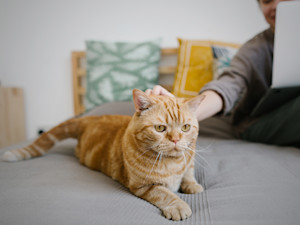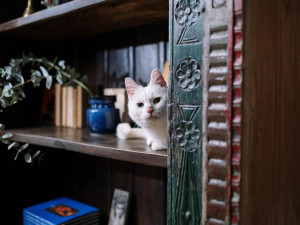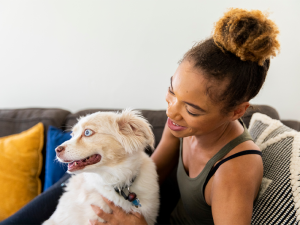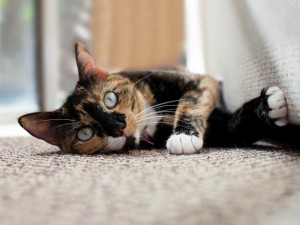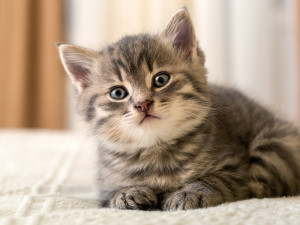What to Know About Eye Infections in Cats
Cats’ eyes are strikingly beautiful, but goopy, irritated eyes are not.
A cat’s eyes are one of their most striking features. Whether blue, green, hazel, or yellow, their crystal-clear irises demand notice (like Liz-Taylor-lavender-eyes-level notice). But sometimes those beautiful eyes become cloudy, goopy, swollen, or squinty. These changes could indicate an infection affecting the eyes.
Cats can get infections in or around their eyes for a variety of reasons. Most infections will resolve with basic care and medication, but some can recur or cause enough damage to result in blindness. But don’t worry. Being aware of what to watch for and when to go to your vet can help head off problems before they get to the worst-case scenario.
What are the symptoms of an eye infection in a cat?
Unlike many other health issues in cats, eye infections in cats tend to be pretty obvious. It’s hard to hide crusty, puffy eyes. Other symptoms include the following:
Increased discharge, often whitish or greenish
Reddened whites of the eye
Cloudy or bluish surface of the eye
A defect on the surface of the eye
Bulging of the eyeball
Pawing at the eyes
Most cats with eye infections will be in pain, too. Cats show signs of eye pain by hiding, shying away from being petted, having difficulty eating, or vocalizing. Some cats will want to rub their gross eyes on you because the pressure feels good.
What causes a cat’s eye to look cloudy?
The clear surface of the eye, called the cornea, should be smooth and shiny. A corneal ulcer or erosion can cause this normally pristine surface to have a divot, flattening, or discoloration. Corneal ulcers occur for many reasons, but some of the most common ones are trauma, viral upper respiratory infection, exposure to caustic agents, such as soap or chemicals, and foreign material. Not all corneal ulcers are infected, but they are a break in the eye’s natural defenses and can become infected.
Sometimes, the clear part of a cat’s eye will appear hazy, whitish, or bluish, but may not have a defect on the surface. This could be due to uveitis, which is a general term for inflammation within the eye. Uveitis can be frustrating because there are many possible causes for it, and some of those causes don’t even originate in the eye.
Uveitis caused by infection is usually due to a penetrating injury, such as a cat claw to the eye (ouch!) or a very deep corneal ulcer. Some systemic infectious diseases, include feline infectious peritonitis, feline leukemia, feline immunodeficiency virus, toxoplasmosis, and certain fungal infections can affect the eyes and cause uveitis as well.
What can cause a cat’s eyes to look swollen?
Inflammation of the tissues around a cat’s eyes can make them appear swollen. Puffy eyelids are commonly associated with either viral or bacterial upper respiratory infections. Some cats will get these infections directly from a sick cat. Other cats acquire viral infections when they are young and develop symptoms again during times of stress.
Less frequently, the tissues within the eye socket will get infected. These types of infections are very painful and will cause the eyeball to bulge. This can be caused by a migrating foreign body or by a deep dental infection. This problem is commonly known as a retrobulbar abscess or retrobulbar cellulitis.
How are eye infections in cats diagnosed and treated?
After a general physical examination and magnified direct examination of the eyes, the most common initial tests for working up eye issues are fluorescein staining, Schirmer tear testingopens in new tab, and checking the pressure within the eye.
Fluorescein stain is a special dye that is applied directly to the surface of the eye. The surface of a healthy eye is extremely smooth, so the dye should wash away completely when the eye is flushed. If there is a corneal ulcer present, the dye will stick to it and glow under black light. The Schirmer tear test checks for normal tear production. Decreased tear formation results in a dry eye that is prone to ulcers or other problems that could lead to infection.
As part of the work-up for eye issues, veterinarians will often use tonometry to check the pressures in a cat’s eyes. Low pressure in the eye is associated with uveitis or a puncture of the eye, while high pressure can be due to a retrobulbar abscess or glaucoma. Your vet veterinarian may recommend an ultrasound, CT scan, or MRI to help make sure there are no scary problems, such as a tumor hiding in or behind the eye.
Treatment recommendations will depend on the disease. Topical or oral antibiotics may be recommended if a bacterial infection is suspected. An E collar (cone) may be needed for cats that are rubbing their eyes and at risk of worsening their problems. Some cats with more serious issues may need a surgical procedure to drain an abscess or help the surface of the eye heal.
How can cat eye infections be prevented?
Cats love exploring the world and getting into unexpected trouble, so it may be impossible to prevent every eye issue. Keeping cats indoors and out of the cycle of territorial drama and illness is a good first step. In cats with a history of upper respiratory infections, maintaining a low-stress environment and recognizing the early symptoms of their infections can help to keep things from progressing


